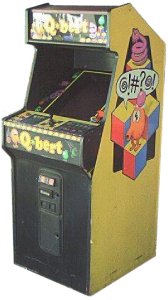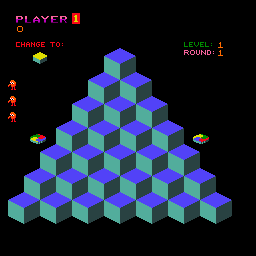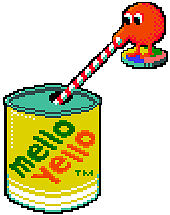 The Game: Q*Bert, a nosey little guy with a propensity for hopping, spends his time hopping around a three-dimensional pyramid of cubes, avoiding Coily the Snake and other assorted purple and red creatures, including a few who operate on a slightly different plane (i.e., they move down the pyramid as if it were rotated
The Game: Q*Bert, a nosey little guy with a propensity for hopping, spends his time hopping around a three-dimensional pyramid of cubes, avoiding Coily the Snake and other assorted purple and red creatures, including a few who operate on a slightly different plane (i.e., they move down the pyramid as if it were rotated  one-third). Any green objects and creatures Q*Bert can catch will not hurt him – in fact, the little bouncing green balls will stop time briefly for everyone but Q*Bert. If he gets into a tight spot, Q*Bert can jump off the pyramid onto a flying disc which will despoit him back at the top of the pyramid – and lure Coily to a nasty fate by jumping into nothing. Changing the colors of the top of every cube in the pyramid to the target color indicated at the top left of the screen will clear the pyramid and start the craziness all over again. If Q*Bert is hit by an enemy or falls off the pyramid, he hits bottom with a resounding, arcade- cabinet-shaking splat and a burst of incomprehensible obscenity! (Gottlieb/Mylstar, 1982)
one-third). Any green objects and creatures Q*Bert can catch will not hurt him – in fact, the little bouncing green balls will stop time briefly for everyone but Q*Bert. If he gets into a tight spot, Q*Bert can jump off the pyramid onto a flying disc which will despoit him back at the top of the pyramid – and lure Coily to a nasty fate by jumping into nothing. Changing the colors of the top of every cube in the pyramid to the target color indicated at the top left of the screen will clear the pyramid and start the craziness all over again. If Q*Bert is hit by an enemy or falls off the pyramid, he hits bottom with a resounding, arcade- cabinet-shaking splat and a burst of incomprehensible obscenity! (Gottlieb/Mylstar, 1982)
Memories: So many arcade games looked like hits and smelled like hits before they actually got an arcade road test, and this archive is itself littered with screenshots of wanna-be hits where every name, graphic and sound were trademarked. Because someone was sure that, for example, Winky from Venture would be a runaway hit. Q*Bert is a case where that optimism – and the marketing muscle behind it – was perfectly justified. With a game concept by Warren Davis, memorable characters from Gottlieb staff artist Jeff Lee and wacky jumbled-synthesized-speech effects by David Thiel, Q*Bert was one of those games that went into orbit instantly. It was almost universally loved and talked-about, and you could count on quite a line at the Q*Bert machine at your local arcade. And this is a rare case where I’ll admit, even in jaded hindsight, that all the praise was so worth it.
 Q*Bert was a challenge to translate to home video game screens, with its vaguely 3-D playing field and vivid colors, as well as the character animations. Another problem was the joystick debate – should home players have to rotate their joysticks 45 degrees for a diamond-shaped joystick (which merely retranslated the up, right, etc. singals into up-right, down-right, and so on), or simply move their joysticks diagonally – something which not all hand controllers of the time could read as well as horizontal and vertical movement?
Q*Bert was a challenge to translate to home video game screens, with its vaguely 3-D playing field and vivid colors, as well as the character animations. Another problem was the joystick debate – should home players have to rotate their joysticks 45 degrees for a diamond-shaped joystick (which merely retranslated the up, right, etc. singals into up-right, down-right, and so on), or simply move their joysticks diagonally – something which not all hand controllers of the time could read as well as horizontal and vertical movement?
Q*Bert inspired a single spinoff, Q*Bert’s Qubes, which was fun in its own way, but lost much of the original game’s unique zaniness. In this game, the cubes rotated in three dimensions each time Q*Bert jumped off of them, and all three visible sides of a cube had to be matched to a target combination, as with the original Q*Bert. Because of the complexity of achieving this, Q*Bert’s Qubes did not require players to complete the entire playing field, opting instead for Tic-Tac-Toe style lineups of a single row.
 Gottlieb was quick to license Q*Bert and his adversaries out for toys, stickers, coloring books, and cartoons, having already seen Midway’s windfall from Pac-Man merchandise. Also, in an unusual move, a special version was created for an arrangement where soft drink Mello Yello “sponsored” Q*Bert, and intermission screens showing an animation of Q*Bert drinking a can of Mello Yello (through his nose, no less) were added to the game. (This wasn’t the only time a video game was sponsored by a
Gottlieb was quick to license Q*Bert and his adversaries out for toys, stickers, coloring books, and cartoons, having already seen Midway’s windfall from Pac-Man merchandise. Also, in an unusual move, a special version was created for an arrangement where soft drink Mello Yello “sponsored” Q*Bert, and intermission screens showing an animation of Q*Bert drinking a can of Mello Yello (through his nose, no less) were added to the game. (This wasn’t the only time a video game was sponsored by a  beverage, however – Budweiser was clearly visible in Midway’s Tapper.) Unfortunately, the Q*Bert merchandising blitz was just beginning to appear when the video game industry crashed in 1983 – and not all of the goodies announced hit the shelves.
beverage, however – Budweiser was clearly visible in Midway’s Tapper.) Unfortunately, the Q*Bert merchandising blitz was just beginning to appear when the video game industry crashed in 1983 – and not all of the goodies announced hit the shelves.